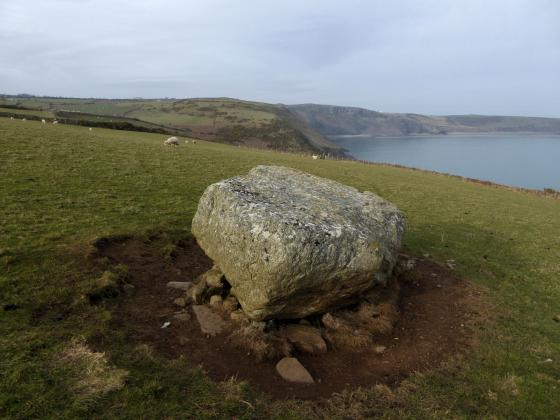
Taken 17th January 2004: Two axe heads found at Mynydd Rhiw, now exhibited at the National Museum and Galleries of Wales in Cardiff.

Taken 17th January 2004: Two axe heads found at Mynydd Rhiw, now exhibited at the National Museum and Galleries of Wales in Cardiff.

Taken 17th January 2004: Two axe heads, broken during manufacture, found at Mynydd Rhiw. These are now exhibited at the National Museum and Galleries of Wales in Cardiff.

Taken 17th January 2004: Two stone knives found at Mynydd Rhiw, now exhibited at the National Museum and Galleries of Wales in Cardiff.

Taken 17th January 2004: A saw (on the left) and an awl (on the right) found at Mynydd Rhiw, now exhibited at the National Museum and Galleries of Wales in Cardiff.

This possibly refers to the stone-walled square holy well at SH242294, just called ‘Ffynnon Sant’ on Coflein.
Myrddin Fardd* [..] mentioned Ffynnon Cefn Lleithfan,, or the Well of the Lleithfan Ridge, on the eastern slope of Mynydd y Rhiw, in the parish of Bryncroes, in the west of Lleyn. In the case of this well it is necessary, when going to it and coming from it, to be careful not to utter a word to anybody, or to turn to look back. What one has to do at the well is to bathe the warts with a rag or clout which has grease on it. When that is done, the clout with the grease has to be carefully concealed beneath the stone at the mouth of the well. This brings to my mind the fact that I have, more than once, years ago, noticed rags underneath stones in the water flowing from wells in Wales, and sometimes thrust into holes in the walls of wells, but I had no notion how they came there.
*aka Dr John Jones. Myrddin was his ‘bardic’ name. From p61 of
Sacred Wells in Wales
John Rhys; T. E. Morris
Folklore, Vol. 4, No. 1. (Mar., 1893), pp. 55-79.
At the top of this page is a description of how to get to Mynydd Rhiw, and some photos of the cairns on the top.







































